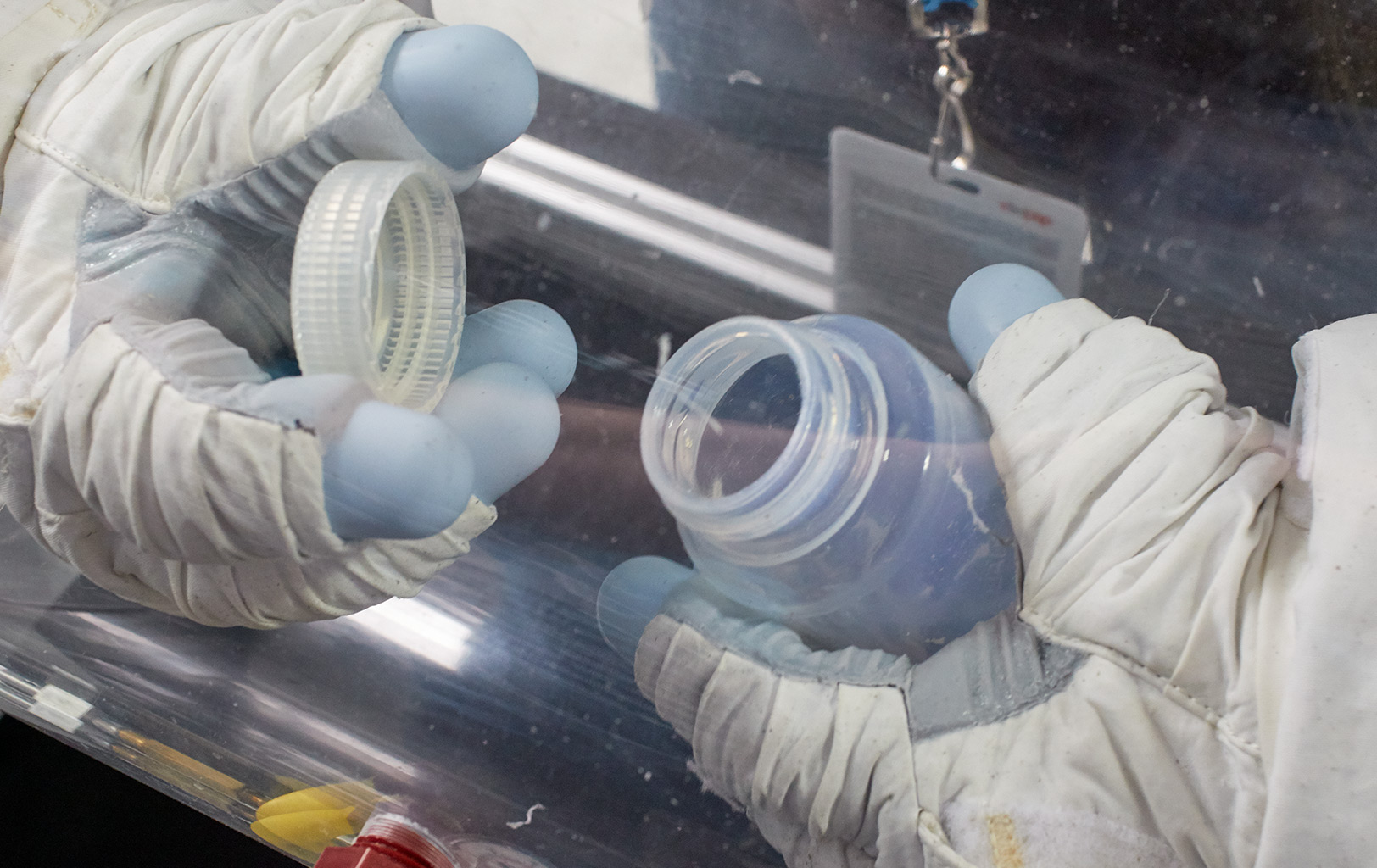What It's Like to Work in Space, Using Bulky EVA Gloves

Tightening a lug nut on the tire of your car in the driveway seems like an easy enough task, but imagine trying to do it while wearing incredibly bulky gloves and working in the vacuum of space. Still sound easy?
That is what a day's work entails for astronauts working outside the International Space Station. A simple task that would otherwise take 5 minutes to complete on Earth can take hours in space.
I had the opportunity to experience a simulation of what it is like for astronauts working in space. I tested out an EVA (extravehicular activity) glove simulator operated by NASA's Langley Research Center at "Star Trek": Mission New York earlier this month. The EVA glove simulator challenged users to put the top on a plastic bottle and tighten it into place. [Weightlessness and Its Effect on Astronauts]
While this sounds like a task someone may complete a dozen times a day — opening a jar of peanut butter, taking the top off a milk carton or water bottle — it is a far different task to complete when working in the vacuum of space (which is a fancy way of saying low-pressure environment).
To begin the simulation, users were given soft gloves to put on before putting their hands in the EVA gloves, which were housed in a plastic box. Inside this box, there was a plastic bottle and top. The air inside the box was drawn out to mimic the low pressure of space and create a vacuum. Then, once a near-perfect vacuum was reached, users had to try to put the top on the bottle.
Although I was able to pick up both the bottle and the top and place the top on the bottle, I could not maneuver my hands well enough to screw the top down into place. Brandon Guethe, an exhibit tech for Space Technology Game Changing Development at the Langley Research Center in Virginia, explained why this task was so hard to complete.
"The biggest problem is that they [astronauts] lose the majority of their dexterity because of the vacuum in space," Guethe said, adding that the gloves also have multiple layers that restrict an astronaut's movement.
Get the Space.com Newsletter
Breaking space news, the latest updates on rocket launches, skywatching events and more!
Guethe, who was operating the simulator at Mission New York, said that thousands of people had tried to complete the task at hand, but only eight were able to successfully screw the top onto the bottle. Guethe noted that firefighters, hazmat technicians and scuba divers who are used to working under extreme conditions while wearing bulky equipment are generally more successful at using the space glove simulator.

Another big problem with operating the gloves is that astronauts can't tell how hard they are actually pulling on something or how hard they need to hold on to a tool when they are tightening a nut or bolt, Guethe said.
"This has actually caused a lot of damage to their hands just because they don't have the circulation … and they don't know how hard they are really grabbing something," Guethe added.
A third major problem Guethe mentioned was the accumulation of moisture and bacteria in the astronauts' gloves.
"They have a lot of problems with losing their fingernails, cuticle damage and fingernail fungus," he said. When astronauts are outside the space station working, the vacuum of space pulls moisture through their skin, into the glove material, Guethe added.
NASA scientists are working to create a "High Performance EVA Glove" that will revolutionize current glove designs.
NASA says current EVA glove designs account for nearly 50 percent of spacesuit injuries reported in the past 18 years. The new EVA gloves, however, are designed to reduce potential injury and improve finger restraint and mobility, according to NASA. The gloves also will have lightweight, dust-tolerant bearings, which is important for deep-space missions, where astronauts may encounter more orbital dust and debris.
In addition, the new gloves will simulate the vibration of texture to give astronauts more dexterity, Guethe said. While astronauts may not be touching anything physically (because multiple layers of thick material separate their hands from the physical object), vibrations will send sensory signals to the astronauts' brains, telling them they are holding something. The more they grab onto an object, the more certain sensors in the glove will vibrate.
Testing out the EVA gloves alone proved to be extremely difficult. Astronauts must not only overcome this challenge but also figure out how to work in an entire spacesuit made of the same thick, restrictive material.
"When they're doing repairs [outside] the space station, it is actually much harder because it's not just the gloves; their entire suit is stifling," Guethe said. "They really don't have that much mobility from the waist up."
To overcome this challenge, astronauts plan and practice for EVAs (aka spacewalks) in a facility called the Neutral Buoyancy Lab — a large swimming pool at NASA's Johnson Space Center that houses a replica of the space station. Astronauts train in this pool for up to 6 hours at a time, wearing their spacesuits.
So, do you have what it takes to be an astronaut?
Follow Samantha Mathewson @Sam_Ashley13. Follow us @Spacedotcom, Facebook and Google+. Original article on Space.com.
Join our Space Forums to keep talking space on the latest missions, night sky and more! And if you have a news tip, correction or comment, let us know at: community@space.com.

Samantha Mathewson joined Space.com as an intern in the summer of 2016. She received a B.A. in Journalism and Environmental Science at the University of New Haven, in Connecticut. Previously, her work has been published in Nature World News. When not writing or reading about science, Samantha enjoys traveling to new places and taking photos! You can follow her on Twitter @Sam_Ashley13.









